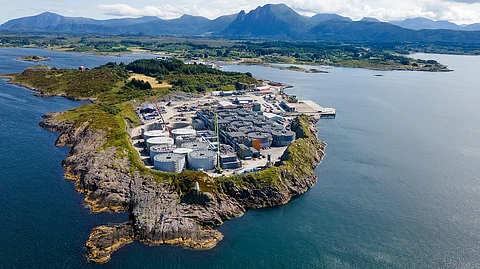

Aerial view of Salmon Evolution's Indre Harøy site near Molde, Norway.
Photo: Salmon Evolution.
Norway's Salmon Evolution has today released its operational update for the third quarter of 2025, reporting it achieved both record overall production levels and its highest quarterly increase in fish biomass to date.
The land-based salmon farming company, which operates a hybrid flow-through facility at Indre Harøy near Molde, Norway, said it harvested 1,387 tonnes of salmon during the quarter, with an average harvest weight of 3.5 kilograms head-on gutted (HOG), marking a 20% increase from the previous quarter. The all-in price realisation was around NOK 61 per kilogram.
Net biomass growth reached approximately 1,800 tonnes live weight (LW), up 6% from the second quarter. Salmon Evolution said this marked the fifth consecutive quarter of quarter-on-quarter biomass growth. The company also reported that its facility was fully stocked, holding a standing biomass of 3,009 tonnes LW by the end of the quarter, in line with its targets for both volume and number of fish.
“Salmon prices recovered during September on back of negative year on year growth in Norwegian biomass, supporting an increasingly tight supply-demand balance going into 2026,” said Salmon Evolution CEO, Trond Håkon Schaug-Pettersen, via a press release.
“With a fully stocked farm and steadily improving production and harvest weights, Salmon Evolution is well positioned to capitalize on this," he added.
At the end of June, Salmon Evolution announced it had reached a new milestone in the Phase 2 expansion of its land-based aquaculture facility in Indre Harøy, having completed two new seawater intake pipelines.
In its last quarterly report, the company said it expected to undertake its first Phase 2 smolt release in the first quarter of 2026, and its first harvest in the final quarter of the same year.
Once the second phase is completed, Salmon Evolution expects to increase its production capacity from its current 7,900 tonnes to 18,000 tonnes per year, with the final phase aiming to reach 36,000 tonnes by 2026.
